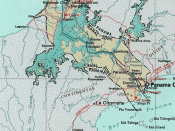The History of the Panama Canal,
By, Aaron Ang
The date is August 15, 1914, where one of the world's greatest engineering marvels, was officially opened by the passage of the SS Ancon. But it was a long and tiring journey, taken over the course of more then a century.
The United States wanted to build a canal because of the shortened journeys for its supply ships, battle ships, and would prove a good place to construct a central military base.
From 1880 to 1900, a French company under Ferdinand de Lesseps attempted unsuccessfully to construct a sea-level canal on the site of the present Panama Canal. In November 1903, with U.S. encouragement and French financial support, Panama proclaimed its independence and concluded the Hay/Bunau-Varilla Treaty with the United States.
The treaty granted rights to the United States "as if it was sovereign" in a zone roughly 10 miles wide and 50 miles long.
In that zone, the U.S. would build a canal, then administer, fortify, and defend it "in perpetuity." In 1914, the United States completed the existing 83 Kilometers lock canal, which today is one of the world's greatest engineering triumphs.
At the time, no single effort in American history had exacted such a price in dollars or in human life. The American expenditures from 1904 to 1914 totaled $352,000,000, far more than the cost of anything built by the United States Government up to that time. Together the French and American expenditures totaled $639,000,000. It took 34 years from the initial effort in 1880 to actually open the Canal in 1914. It is estimated that over 80,000 persons took part in the construction and that over 30,000 lives were lost in both French and American efforts.
Most of the lives was lost to diseases, but...


